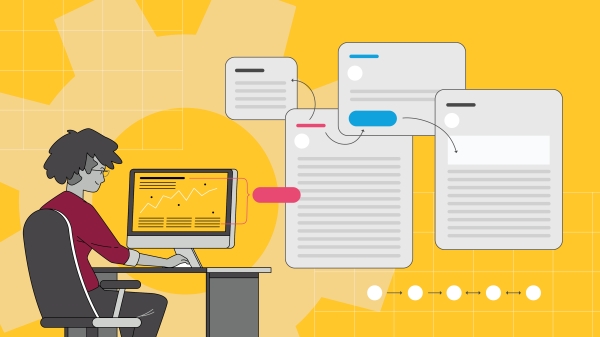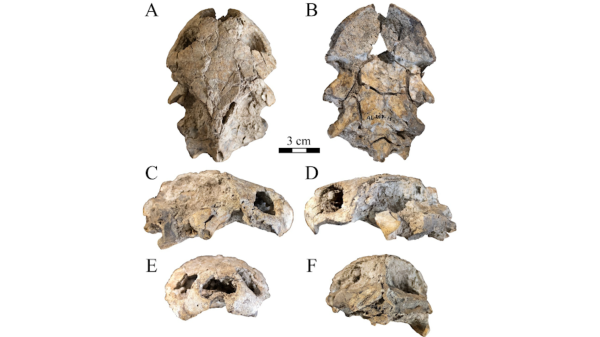Chief engineer of CXFEL talks taking concepts to reality

Mark Holl, chief engineer and deputy director of the CXFEL Labs, explains the compact X-ray free electron laser at an event in 2019. Photo by Charlie Leight/ASU News
Editor's note: This is the final installment of a five-part series profiling the researchers who work on ASU's compact X-ray free electron laser. Read the previous installments: Q&As with CXFEL Labs Chief Scientist William Graves, Regents Professor Petra Fromme, CXFEL Labs Director Robert Kaindl and Assistant Professor Sam Teitelbaum.
Mark Holl has been laying the foundations for the compact X-ray free electron laser (CXFEL) project since 2016.
When the CXFEL was just an idea, Holl was hard at work on its purpose-built laboratory. Working alongside architects and structural engineers, he ensured that the space in Arizona State University's Biodesign C building was built as specialized as the instrument itself. The resulting facility rests on a massive, 1,200-cubic-yard concrete slab to mitigate vibration and is surrounded by 4-foot thick, shielded concrete walls to fully contain accelerator-generated radiation.
In addition to overseeing the design and construction of the laboratory, Holl was responsible for taking the compact X-ray light source (CXLS) from idea to reality, transforming physics concepts into hardware.
Now that the CXFEL project received $90.8 million in funding from the National Science Foundation to construct the groundbreaking instrument, his work continues. As chief engineer and deputy director of the CXFEL Labs, Holl translates the CXFEL’s lofty physics requirements into engineering specifications and physical hardware and oversees the construction of this one-of-a-kind instrument.
In this Q&A, Holl discusses his influences and expertise, and how he applies those to his day-to-day work on the CXFEL.
Question: What are you known for? Or what expertise do you specifically bring to the team?
Answer: I’m an interdisciplinary engineer with years of experience in engineering project management. This first-of-its-kind project demands that I am both very detail-oriented and focused on disparate elements but also able to step back and brainstorm on a big-picture level with my colleagues. I consider myself a focused team player that values and relies on integrated project teams to achieve the complex objectives laid before us.
Q: What has been one challenge in the CXLS project and how have you and the team overcome it?
A: Our team encounters challenges and formulates and executes solutions on almost a daily basis, so it’s really just business as usual. One recent obstacle we overcame was related to the generation of the first X-rays from CXLS.
To achieve this milestone, the electron pulses and laser pulses needed to be aligned in space and time to collide and produce the desired X-ray pulses. While this seems pretty straightforward, both electron and laser pulses come in at 1,000 pulses per second and are very small — microns in diameter and about a micrometer in length.
It took us weeks of refinement to develop repeatable protocols that now enable routine alignment. It was the combined effort, expertise and problem-solving ability of all team members that made this possible, and serves as a prime example of the strength of collaboration on this project.
Q: Why is ASU the right place to build these instruments?
A: There is a unique environment at ASU and the Biodesign Institute established and sustained by the vision of President Michael Crow. Building instruments such as CXLS/CXFEL requires long-term vision and commitment — not unlike the Apollo program, which achieved the audacious goal of landing men on the moon and enabled entirely novel discoveries. Anything short of that vision and commitment would fail to achieve the game-changing instrumentation that we’re striving toward.
Q: What was the moment when you discovered your passion for science?
A: From a very young age, I remember a desire to understand how things work, how they are designed and how they are assembled. I attribute this less to an exact moment and more a span of time. My mother worked with engineers at universities and often brought me to work, so I was exposed to the research process and laboratories early on. I also vividly recall the moon landing and asking for a Saturn V rocket kit to build for Christmas. These early influences may explain why I constantly find myself in roles that require a passion for engineering and systems integration and grit and determination to meet objectives.
Q: What were other pivotal moments in your career that led you to where you are today?
A: There have been many pivotal moments and people in my life and career that are part of a tapestry leading to where I am now. I had an exceptional shop teacher in middle school, Steve Duncan. My stepfather, Jon Grimes, was an instrument-maker and later managed the engineering instrumentation shops at Washington State University, where I worked as an undergraduate attaining journeyman status.
I had many professors as an undergraduate who opened doors to new knowledge and provided mentorship and models which I sought to imitate or emulate. As a graduate student, the same was true where I was fortunate to have exceptional advisors and mentors as I trained as an engineer and scientist, including Joseph Garbini, Ashley Emery and Vipin Kumar. My postdoctoral advisor, Paul Yager, was also very important to my career.
At ASU, I have worked with many remarkable colleagues on challenging projects culminating with the CXFEL project. Meeting Petra Fromme and joining her lab was certainly essential to where I am today. Working with Petra, John Spence and Bill Graves has been a remarkable and formative experience for which I am committed and grateful. I consider all of these interactions to have provided essential role models and mentorship to my personal and professional development.
Q: What motivates and excites you most about your work?
A: I'm an engineer, and engineers exist on teams to help people realize their visions. But I’m one member of a team full of people, and teams must collaborate to ensure short- and long-term success. This is especially true of instrument design — collaboration throughout is essential because many iterations are often needed to perfect function. In addition, involving the end users of an instrument throughout the design and commissioning ensures they take enthusiastic ownership of the completed systems.
Q: You’ve designed and constructed many other labs and equipment before. How does CXLS/CXFEL compare to previous projects?
A: The research facilities I’ve designed and developed throughout my career all necessitated a similar process to collect and craft a set of research requirements, translate those requirements into engineering specifications, and then translate specifications into instrument designs and facility requirements.
Moving through this process with the outstanding scientists of CXLS/CXFEL has been the most challenging and rewarding project of my career. I am immensely grateful for my colleagues and their expertise. Developing CXFEL Labs requires all the experience and knowledge that specialists can bring to the table, as well as engineering with a systems integration approach, which I bring to the team. At the end of the day, projects like those within CXFEL Labs can only succeed with highly skilled and highly motivated integrated project teams.
Q: Can you talk a little about student involvement in CXLS/CXFEL?
A: This project has been blessed with remarkable undergraduate and graduate students, and they are truly a lifeblood of CXFEL Labs. It’s no exaggeration to state that the CXLS instrument was largely assembled and tested by students under faculty and senior staff supervision and guidance. Our students come from a diversity of disciplines and diverse backgrounds as well. What unites them is a thirst for knowledge and a drive to work across disciplines, and I’ve had the pleasure of working with almost all of them.
Q: What are you looking forward to about CXFEL? What excites you about its future?
A: Over the next few years, there will be plenty of challenging engineering science to keep me busy as I continue to develop and optimize new engineered systems and refine the first generation of CXFEL Labs instruments. And I especially look forward to seeing these instruments in use — and seeing how William Graves, Petra Fromme, Robert Kaindl and Sam Teitelbaum, and others, advance new science within their respective areas of expertise. As I said, as an engineer, I’m on this team to realize the vision of CXFEL, and I’m excited to see what that looks like.
Biodesign Institute and its CXFEL Labs are partially supported by Arizona’s Technology and Research Initiative Fund. TRIF investment has enabled hands-on training for tens of thousands of students across Arizona’s universities, thousands of scientific discoveries and patented technologies, and hundreds of new startup companies. Publicly supported through voter approval, TRIF is an essential resource for growing Arizona’s economy and providing opportunities for Arizona residents to work, learn and thrive.
More Science and technology

New research by ASU paleoanthropologists: 2 ancient human ancestors were neighbors
In 2009, scientists found eight bones from the foot of an ancient human ancestor within layers of million-year-old sediment in…

When facts aren’t enough
In the age of viral headlines and endless scrolling, misinformation travels faster than the truth. Even careful readers can be…

Scientists discover new turtle that lived alongside 'Lucy' species
Shell pieces and a rare skull of a 3-million-year-old freshwater turtle are providing scientists at Arizona State University with…